In 2022, I began to read the Rama-Krishna Canon, beginning with the Bhagavad Gita. By 2023, I had finished the Mahabharata and the Ramayana. These texts are incredibly compelling, and at least as beautiful and compelling as the Bible.
The dating of these texts is controversial, similar to the Bible. With regards to Judaism, the earliest claim maintains that Genesis was written around the time of Moses, 1400 BC. Biblical critics claim that the text was written after the Babylonian captivity, but prior to the Alexandrian conquest, around 400 BC.
While fragments of the New Testament have been found and dated to the period in which they are claimed to have been written, no such fragments exist for the Rama-Krishna canon. The Rigveda, which supposedly precedes both of them, can only be found in fragmented forms dated to 1040 AD.1 The earliest Sanskrit inscriptions date only to 150 AD.
It is always possible to suggest an oral tradition stretching back much farther. From the testimony of Julius Caesar, we know that the Celts had an extensive international religious hierarchy which spanned France and Britain, had regular “synods,” and even a “pope,” all without the use of any known writing. My point here is not to dismiss the possibility of an oral tradition, but to suggest that many of the innovations of the Rama-Krishna canon may have occurred simultaneously with other innovations in the Indo-European world, including the Greek cult of Dionysus, and the Iranian cult of Ahura Mazda.
Agni as the Precursor to Rama-Krishna
The Rigvedic religion contains several recognizable Gods. Indra, God of lightning, God of kings, slayer of dragons, is clearly drawn from the same source as Zeus and Thor. Surya, God of the sun, is similar to Apollo, Helios, and Sol Invictus. Agni, God of fire, is also the God of priests and sacrifices. Agni seems to be a fusion of the Greek concept of Mercury and Vulcan. He is a volcanic consuming God, similar to the apparition of Yahweh as a pillar of fire (Exodus 13:21). At the same time, he is a messenger God, a psychopomp, and associated with the fire God Brihaspati, who is said to be the God of speech. Both of these attributes make Agni extremely similar to Mercury. Agni, Mercury, and Odin all are Gods of esoteric knowledge, magic, and the priest class.
Agni is the chief God of all priests in the Rigveda — but Indra clearly maintains his supremacy as king of the Gods. By the time of Caesar, the cult of Odin had successfully taken over the Norse religion, removing the former primacy of the God of kings, Tyr. The cult of Agni can be seen as an attempt to defeat the cult of Indra, which was aborted and unsuccessful, and eventually “syncretized” with the cult of Indra in the Rigveda.
Vishnu-Rama
After the cult of Agni failed to supplant the cult of Indra, the cult of Vishnu-Rama was introduced. Vishnu seems to be a God of sky-water, similar to Uranus and many of the Gods of Babylonia. Rama, as an incarnation of Vishnu, must contend with Ravana, the disciple of Shiva. Shiva may be identical to Rudra, the roaring one, God of storms, identical to the God of the wild hunt which was absorbed into the cult of Odin.
A clearer distinction between the forces of order and the forces of chaos cannot be made. Ravana is a usurper, an invader, a pirate, a rapist, defined by his Faustian quest for knowledge, his devotion to scripture, and his invincibility granted by Brahma. He ascends to Godhood, and defeats all the Gods.
The cowering Gods are humiliated and demoralized by their defeat at the hands of a mortal. This story bears a similar resemblance to the “thousand eyes of Indra.” In this legend, Indra spied on the wife of Gautama (the Buddha). As a result, his body was covered in thousands of vaginas as punishment for his lust — these vaginas later opened and became eyes.
The humiliation and replacement of Indra as God was not a singular event, but the result of an intergenerational struggle by the priest class to subjugate what was ultimately a foreign God, both to their Dravidian civilization, and to their class as priests.
The Upanishadic Civilization
The Upanishads precede the Indo-European invasion.2 The content of the Upanishads is essentially pacifistic. Such a text would be insufficient to produce an aggressive conquering spirit, but would be entirely appropriate to administrate an already subjugated population.
One of the most pernicious lies of the 19th century is the idea of an Aryan caste system. The concept of an Aryan caste system was adopted by the British, who sought to reinforce their rule over India by imagining themselves as “returning India to its roots.” The British conception of an Aryan caste system was itself reinforced by the Vedic texts themselves, in which the terms “Aryan” and “caste” were always intertwined. Therefore, the deception did not begin with the British, but with the texts themselves.
In reality, the caste system pre-dates the Indo-European invasion. The term “Aryan” here needs to be differentiated:
The haplogroups R1a and R1b, often associated with Aryan invasions;
The Indo-Europeans of Iran, Afghanistan, and later India; the Yamnaya-Kurgan culture, which originated somewhere between Kazakhstan and the Black Sea.
These two are often conflated, but some distinctions need to be made.
Whereas R1b is associated with Villabruna 1, 12k BC, found in northern Italy, R1a is found in north-east Russia around 11k BC.
The ancestor of both R1a and R1b is R, and this haplogroup does not necessarily correspond with the Indo-European urheimat. The origins of the R haplogroup can be traced by analyzing the position of R1a and R1b alongside the distribution of haplogroup R2. Rather than finding the R haplogroup as originating along the Black Sea, we find it to originate further to the east, possibly in Kazakhstan.
The point of this is to say that, although R1a and R1b are both associated with Indo-European invasions, they both significantly predate the appearance of any kind of Yamnaya-Kurgan culture, religion, or Indo-European language.
The Indo-European culture arose as the result of a sudden civilizational collapse around the Black Sea between 6200 BC and 5600 BC. Horse domestication, an integral part of the Yamnaya-Kurgan culture, began first in Kazakhstan in 3500 BC. The first chariots are found in the Sintasha culture, on the border between Russia and Kazakhstan, as early as 2000 BC. The “package of technology” which resulted in the Indo-European expansions could not have preceded these dates.
Yet despite the fact that no Indo-European invasions could have occurred prior to 3500 BC, it is clear that between 12k BC and 6k BC, haplogroups R1a and R1b had already spread far and wide around the world, including both India and Egypt. Thus, their expansion cannot be simply attributed to horses and chariots, as the later Indo-Europeans used. Rather, these earlier R1a-R1b expansions occurred as a result of the religious evangelism, military campaigns, and mercantile activity which largely emanated from a Black Sea Civilization. This civilization was capable of sea-faring. For the Greeks, such a civilization was called “Atlantean,” because of the association with subsequent sea-faring in the Atlantic ocean. In reality, it did not originate in any submerged Atlantic islands, but emerged in a now-submerged Black Sea region.
The Upanishadic Caste System
The religious traditions of the Black Sea civilization likely had much in common with both the Dravidian-Upanishadic religion, as well as the Egyptian-Coptic religion. Both of these religions had a caste system long before any Indo-European invasions. Thus, the ethno-religious caste structure was not an Indo-European innovation, but something which Indo-Europeans adopted after layering themselves on top of an existing society.
When Indo-Europeans finally did invade India after 2000 BC, they did encounter a functioning caste system which was already firmly in place. Like the Egyptian caste system, priests or Brahmin were placed above warriors. This was not, and could not have been, the structure of Indo-European society.
In order to travel from the Indo-European homeland in the Black Sea region to Iran, Afghanistan, and India, the Indo-Europeans had to use horses and chariots to subdue their enemies and establish themselves as an aristocracy. Unlike the Dravidian, Egyptian, and Upanishadic civilizations, Indo-European culture was, as Spengler described, barbaric. It was not interested in pacifism or ritual burn offerings.
Bronze Age Conquistadors
Even if the Indo-Europeans did have a caste system back home, it was not able to take any priests or merchants with it for a military campaign. For an analogy, consider if the campaigns of the conquistadors had not been continuously resupplied by their home country, and simply had to fend for themselves among hostile natives. While many elements of Christianity may have dominated the resulting society, it would only be pragmatic for some elements of the indigenous religion to compromise itself with the invaders.
It is possible, by the way, that this already occurred in previous centuries in South America:
"Many within the Aztec Empire came to believe that Cortés was Quetzalcoatl the god who would return to overthrow the god Tezcatlipoca, who demanded human sacrifice. [..] Montezuma II, the Aztec emperor, professed a fear that the Spaniards were followers of the white-skinned and bearded Teotihuacán god, Quetzalcoatl, who had been exiled by the Toltecs because he forbade human sacrifice and had promised a return from across the sea to enforce his law."3
It seems plausible that a small band of warriors invaded South America at some point in the distant past, forbade human sacrifice, and were later destroyed by a rebellion against their rule. However, legends of the myth persisted. Archaeological and genetic evidence of such an invasion would be slim, especially if the aboriginals took it upon themselves to cremate the remains of the invaders, or toss them into the ocean, in order to insult their memory. This is likely what the followers of Zoroaster and Yahweh attempted to do to the religions which they conquered.
Animal Sacrifice
The Indo-European tradition of animal sacrifice involved hunting and pursuing wild animals. In the Mahabharata, this is illustrated in the Ashvamedha, the horse sacrifice of King Yudhishthira.4 The horse is allowed to wander, and wherever it goes, the King must defeat the locals in battle, until finally the horse wanders home, where it is sacrificed. Other Indo-European sacrifices include the sacrifice of the bear, the wolf, and the lion. Once killed, the animal would not be burnt, but its coat would be worn by the king, as in the case of Hercules. Indo-Europeans believed that by killing animals and wearing their coats, they would adopt certain aspects of strength from that animal.
This is an entirely different tradition of sacrifice from the Hebrew or Dravidian, which sacrifices butters, oils, burnt cows, sheep, goats, and other domesticated animals. Whereas Indo-European animal sacrifice was a “wild hunt,” animal sacrifice in Pelasgian, Afro-Asiatic, and Dravidian civilizations was a derivation of human sacrifice. The destruction of these human sacrifice cults is represented by the slaying of the “dragon,” where the dragon represents a female, elderly priest (Medusa) who kills and eats young women.
The Celtic and Aztec forms of human sacrifice give us a glimpse into how Semitic and Dravidian human sacrifice must have occurred prior to the transition to animal sacrifice. The sacrifice of innocents, scapegoating, was unknown to Indo-European culture. Human sacrificing cults, and later scapegoating cults, were meant to symbolically demoralize and pacify the population. Indo-European “wild hunts” were meant to embolden, to challenge young men and to induce feats of strength and courage.
The Divine Orgy
With Agni, Vishnu, Shiva, and Rama arrayed against Indra, the cult of the old Indo-European storm God was eventually humiliated and replaced with an older cult of pacifism. However, the Ramayana still contains many heroic and Kshatriya virtues. It is supremely embarrassing to the Upanishadic spirit that Rama was, first and foremost, a warrior. He was not a celibate priest, but a married man. Indra was not overcome by his opposite, but by a “compromised” warrior, who appealed to the Indo-European Kshatriya virtues, but implanted a subtext of Brahminical supremacy. This contradictory and paradoxical conflict between the supremacy of the warrior and priest was already present in the Rigveda, but becomes more pronounced with the Ramayana.
By the time of the cult of Krishna, the cult of the Upanishads re-emerged triumphantly. The battle of Kurukshetra is explicitly a plot by Krishna to destroy all Kshatriya — it is a genocide of Indo-European warriors. Unlike Rama, who descends from Surya, the Indo-European sun God, Krishna and the Pandavas descend from the Chandravamsha, the lunar dynasty, founded by the transexual God Ila-Sudyumna. Ila, or Ida, is a goddess of speech, and married Budha, the planet Mercury. Ida is also represented as a cow to be sacrificed, in the same way that Christ is the lamb to be sacrificed.
Krishna’s plot to create the Pandavas is orchestrated in a divine orgy. Pandu, king of the Aryans, is made into a celibate monk by the threat of a Brahmin in the form of a deer, who curses him that if he has sex, he will die. This is similar to the scene in the garden of Eden, where Yahweh curses Adam that if he “eats the apple,” he will die. Cults of pacifism seek to vilify both the sex drive, as well as the drive for violence, since they are intertwined.
Once Pandu is spiritually castrated, his wife, Kunti, the mother of the Pandavas, is subject to a “divine orgy of the Gods.” She is impregnated by Indra, Vayu, Yama, and the Ashvin twins. As a result, she gives birth to five brothers. As will be revealed later, her first lover, who she lost her virginity to, was actually the God Surya, the Indo-European solar God. The metaphor here is that Krishna will steal the Indo-European mother away from her first love (the Indo-European religion), and deliver her into the Dionysian orgy, by castrating, humiliating, and pacifying her husband.
The sexual deviancy does not end there. The five brothers, the Pandavas, all marry one woman, Draupadi, and take regular turns having sex with her.
Just as the Ramayana appropriates many authentic and unmistakable features of Indo-European morality and culture, the Mahabharata is replete with similar examples. The heroic sacrifice of the warriors on the battlefield of Kurukshetra, as well as the redemption of Duryodhana, show that the coming of Krishna was not theologically absolute. Unlike Zoroaster, who managed to exterminate Iranian religion and replace it with an entirely new religion, the Indo-European religion in India was too entrenched to be extinguished. It was dismantled gradually, piecemeal, over time, not by demonizing the old Gods, but by humiliating and belittling them with new ones. Indra was not turned into a demon, as in Zoroastrianism, but he was covered with vaginas.
For this purpose, the “divine orgy” was a common tactic, not just by the cult of Krishna, but also by the cult of Dionysus in Greece. The orgy is the inversion of the harem. Although in modern parlance “orgy” has no gendered connotation, its presentation in The Bacchae as well as in the Mahabharata show that the orgy was focused on catering to and satisfying female sexuality. Lesbianism and “gang bang,” are catered to female pleasure. The fact that these topics are sought out by men watching pornography does not change this — Dionysus is the God of male voyeurism. The entire concept of voyeuristic sexuality is a Dionysian cultic practice.
Conclusions
The Indo-European religion and culture was founded upon the “wild hunt” — a test of masculine, warrior virtue, where men would hunt dangerous wild animals at night, such as wolves, bears, lions, and horses. The last of these would eventually be captured instead of killed and domesticated in northern Kazakhstan around 3500 BC. This led to the invention of the chariot around 2000 BC. When Indo-Europeans began to expand outside their ancestral homelands, they encountered large pacifistic empires where sexuality and violence was morally chastised, and where human sacrifice or the sacrifice of innocent animals (lambs, cows, and goats) or food products (oil and butter) was still practiced en masse.
When Indo-European technology suddenly collided with a short, weak, pacified, and morally stunted population, it led to some of the greatest and most lop-sided military defeats in the history of humanity. Empires were destroyed overnight, and gave way to the rule of an Indo-European aristocracy.
However, in most cases, the Indo-European aristocracy did not exterminate the priest class of the old religion. Instead, the priest class subjugated itself to the Indo-European aristocrats, and offered its worship. At first, these aristocratic kings were worshipped as God-kings: Indra, Tyr, and Zeus were all archetypal mythologizations of a real class of men who walked the earth. Over thousands of years, however, this original “Rigvedic” or “Olympian” religion was degraded and humiliated by the degeneration of the warrior aristocracy and a resurgence of the priest class.
19th century historians dated the laws of Manu to 1250 BC, but modern scholars suggest they are much later, around the 1st century AD. In either case, it is clear that the appearance of the God Agni already represents an early “syncretization” of Indo-European religion with Upanishadic religion. Next, Vishnu incarnates as Rama, who defeats the forces of the wild hunt (Ravana, disciple of Shiva-Rudra, God of the wild hunt). Finally, Krishna incarnates out of a transexual moon-cult to initiate his followers with male celibacy and female-oriented orgies. His explicit, stated purpose throughout the Mahabharata is to eliminate the race of Kshatriya from the earth, by pitting the nobles against one another. The parallels in the text to the First and Second World Wars is obvious.
While the cult of Dionysus in Greece and Rome was not successful at dethroning Zeus and Apollo, the cult of Jesus did eventually succeed in imposing a cult of pacifistic celibacy on Europe, centered on the image of a sacrificial lamb. As in India and Iran, such a cult was effective at pacifying the population, decreasing the occurrence of violence, and increasing the efficiency of state bureaucracies. As in the case of Agni and Rama, the introduction of Christ did not entirely eliminate the European warrior class, and Europe has expanded since despite the influence of sacrificial, pacifistic celibacy.
At this point, however, Europe finds itself past the age of Krishna. Europe’s Kurukshetra, which was fought at Verdun, the Somme, Stalingrad, and Kursk, exhausted Europe’s warrior class and revealed the orgy hidden within the Christian message. In the orgy, all are equal. What remains is for the new Brahmin, following Zoroaster, Yahweh, and the French Revolutionaries, to systematically eliminate every vestige of the Indo-European warrior culture which emerged out of the steppe over four thousand years ago. In its most superficial, day-to-day appearance, this looks like a struggle between “left” and “right.” But the ultimate victory of the priest class will not result in “progress” or “freedom,” but an endless conservative, traditional stasis. Against this imprisoning force stands the spirit of the steppe, waiting to return.
Michael Witzel (1997). The Development of the Vedic Canon and its Schools : The Social and Political Milieu. https://web.archive.org/web/20200804151138/http://www.people.fas.harvard.edu/~witzel/canon.pdf
See Michael Nagler’s introduction to The Upanishads, (2007), translated by Eknath Easwaran.
See counter-arguments here: https://academic.oup.com/ahr/article-abstract/108/3/659/22429
(2020) The Great Indo-European Horse Sacrifice 4000 Years of Cosmological Continuity from Sintashta and the Steppe to Scandinavian Skeid. https://uu.diva-portal.org/smash/get/diva2:1435564/FULLTEXT02.pdf







